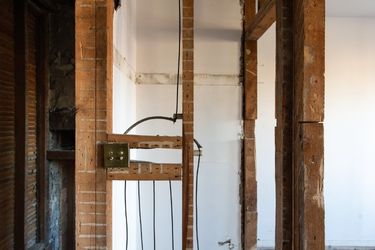
Written by Kayla Jane Barrie Updated on Feb 26, 2025 5 mins read

Did you find out your home has knob and tube wiring? If you are considering buying an older home, it is crucial to understand how to identify knob and tube (K&T) wiring. This outdated type of wiring can pose a serious fire hazard. Still, it can be classified as safe if installed and maintained properly.
Consider the pros and cons if your current property or future home has K&T wiring. In this blog, you will learn about the current challenges and safety issues with this type of electrical system and how it can impact your Ontario home insurance.
In the early 1900s and 1940s, knob and tube wiring were less expensive than other methods of electricity in homes. The name comes from the ceramic insulators that support the wires around bends and beams around the house. It is also more common in buildings with 60-amp service.
There may be wires running through porcelain cylinders, or tubes, inserted in holes along wooden floor joists. Porcelain knobs help keep the wires secure and prevent wires from touching. The wires are insulated with a piece of rubberized cloth fabric versus today’s wires insulated with plastic.
The main difference between modern wiring and K&T is that there is no grounding wire, and it can’t power today’s appliances and electronics. Modern wires have black, white, and ground wires enclosed in a single cable, but knob and tube electrical all run separately.
No law in Canada’s building code states that knob and tube are illegal or need to be removed, but it is considered a hazard and can’t be used in new construction.
Knob and tube wiring is an obsolete method in today’s buildings. Until the Second World War, homes were built with K&T – keep in mind they did not use the number of electronics and appliances we do now, which is where the danger lies. This increase in electrical load can cause strain on the wires, resulting in a fire hazard.
Other dangers of knob and tube wiring include :
If your home happens to have K&T, you should :
Even making the above points does not guarantee your home can get insured with knob and tube electrical. Taking the proper precautions to ensure the wiring is correctly installed can make it safer, but updating is recommended.

Knob and tube wiring is made of copper, one hot and one neutral, that runs through porcelain knobs and tubes. It is covered in insulation, and the knobs hold the wire in place, generally in contact with the wooden beams of the house. The tubes are designed to protect the wire from being in contact with wood or drywall and fraying.
Replacing knob and tube wiring can cost between $5,000 to upwards of $10,000. The cost depends on how big your home is, how much of the wiring exists, and assuming there are no major issues found during the renovation. Most of the work involves removing or replacing drywall and ceilings, pulling out the old wiring, and installing the new receptacles and wiring. All work needs to be inspected by a licensed electrical inspector.
Just because you can’t see it doesn’t mean you don’t have it. Knob and tube electrical are still present in many older homes, and it is quite easy to identify. You can usually find it in your basement or attic. It is identified by white ceramic, spool-like tubes and knobs. You can make holes in walls or send a tiny camera inside to take a look.
Did you know that if your home is over 30 years old, your insurer may require you to upgrade the wiring in your home before providing or renewing your policy?
It can be challenging to get coverage with knob and tube wiring. If they do approve K&T wiring, your costs will be much higher. This type of wiring is the most dangerous and is associated with increased safety hazards.
Depending on your provider, you may be able to get coverage after a licensed electrician inspects it. You may also be able to get coverage from a specialty insurer.
It depends - policies vary, and they may or may not cover knob and tube wiring. Talk with an expert to compare your options for getting coverage if you have knob and tube electrical.
If you have knob and tube wiring in your house, here is what you can do to keep your home safe :
Yes – you should disclose knob and tube wiring to your insurer. If you need to make a home insurance claim and the cause was from the wiring, your claim could be denied.
Since knob and tube wiring does not have ground wiring, it is incompatible with many modern appliances. It increases the risk of electrical shock. The wiring poses a fire risk if they contact each other or become over-insulated.
Knob and tube wiring is legal in Ontario; however, it needs to meet Ontario home insurance requirements and must be inspected by a certified electrician.
Knob and tube wiring stopped being used in homes around the 1950s to 1960s.
Knob and tube wiring can last years, but not as long as copper can. Copper wiring can last up to 100 years and has fewer issues.
Although some types of electrical can be safe as long as they are certified and installed properly, it’s important to make sure you have the correct home replacement cost and coverage in case something happens.
| Categories | Home |
|---|---|
| Tags | Home MaintenanceProtect Your HomeHome Coverage |
Read our insurance blog to get helpful tips, information and news.
Drive safe this winter! Check out these tips for driving in snowy and icy conditions in Ontario. Get other helpful info and FAQs on winter driving.
Drive safer this winter. Learn how the right set of winter tires drastically reduces stopping distance and risk on ice and snow. Get expert tips from your trusted insurance provider.
Ontario municipalities have until November 14 to remove all automated speed enforcement cameras following fast-tracked provincial legislation. This post breaks down why the government is removing them, the pushback from road safety advocates, and what alternative measures will replace them.
What is specified perils insurance coverage? Learn about named perils policies for Ontario drivers. Get info about coverage, if you need it & answers to common questions.